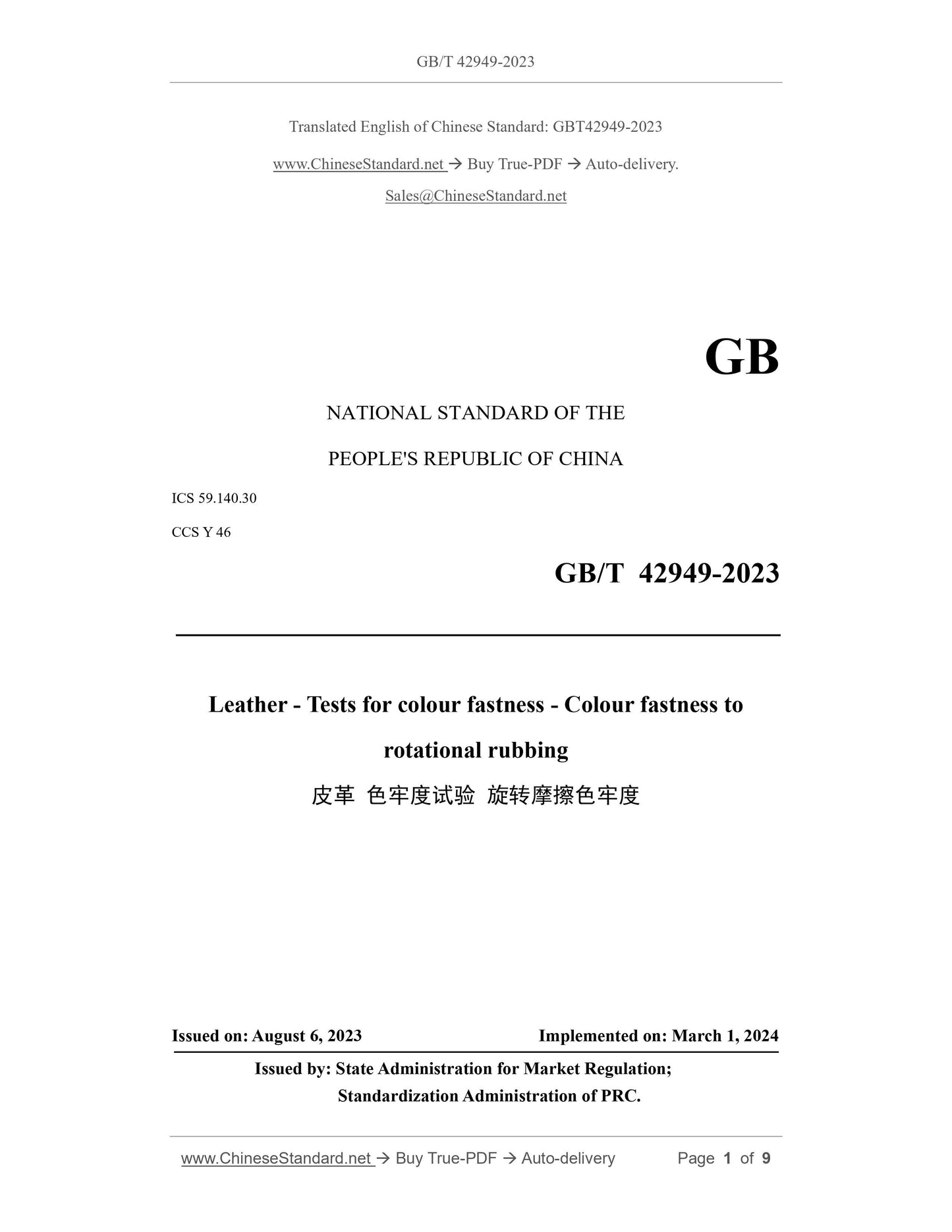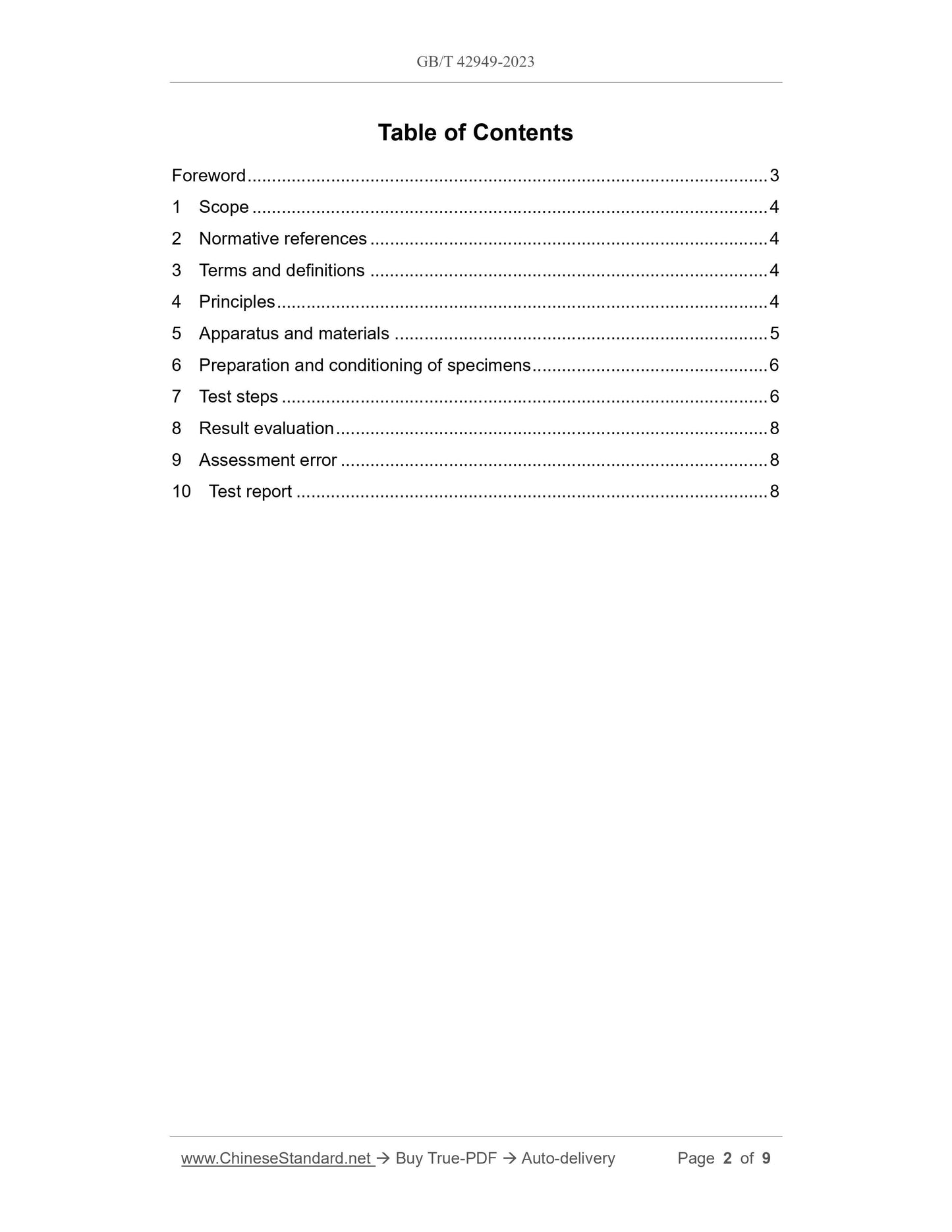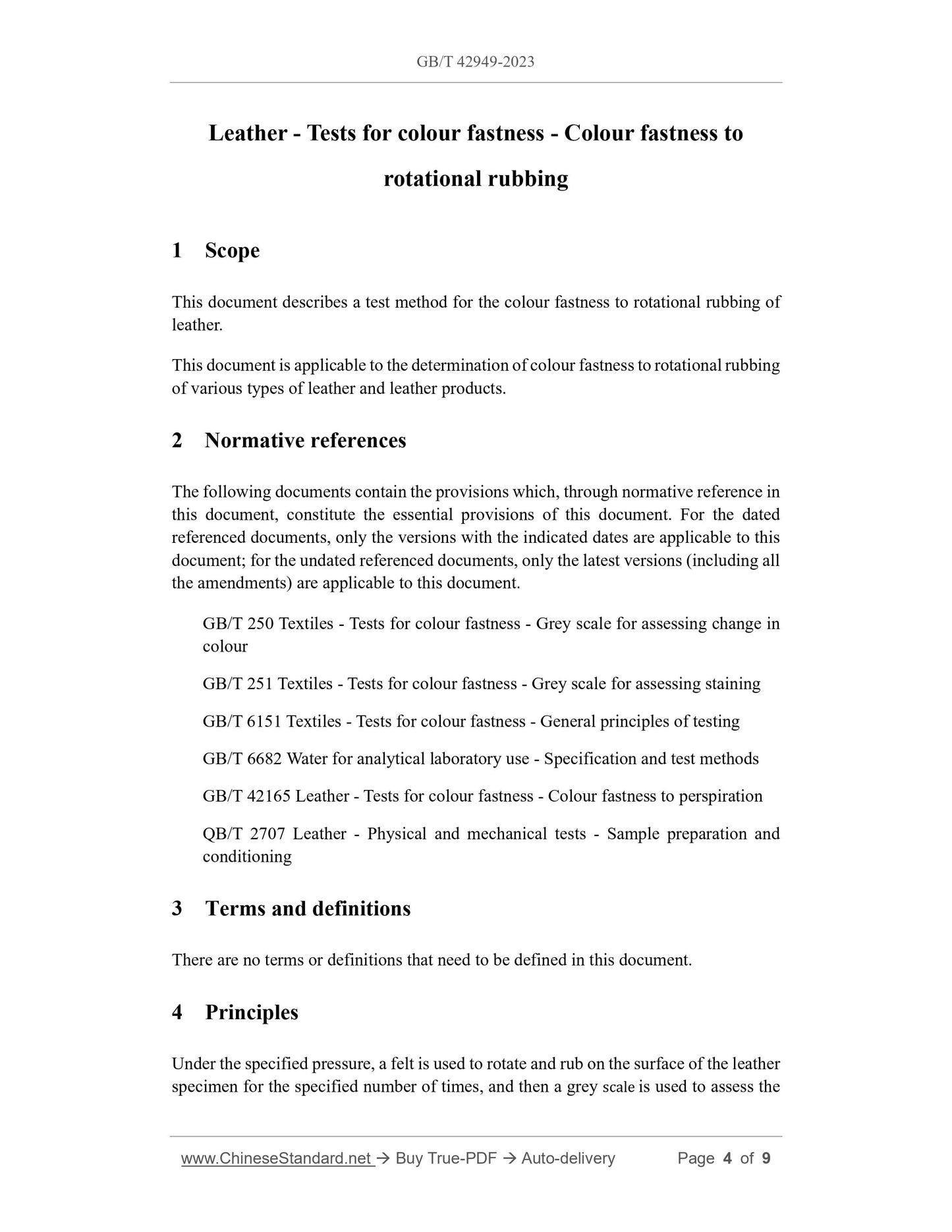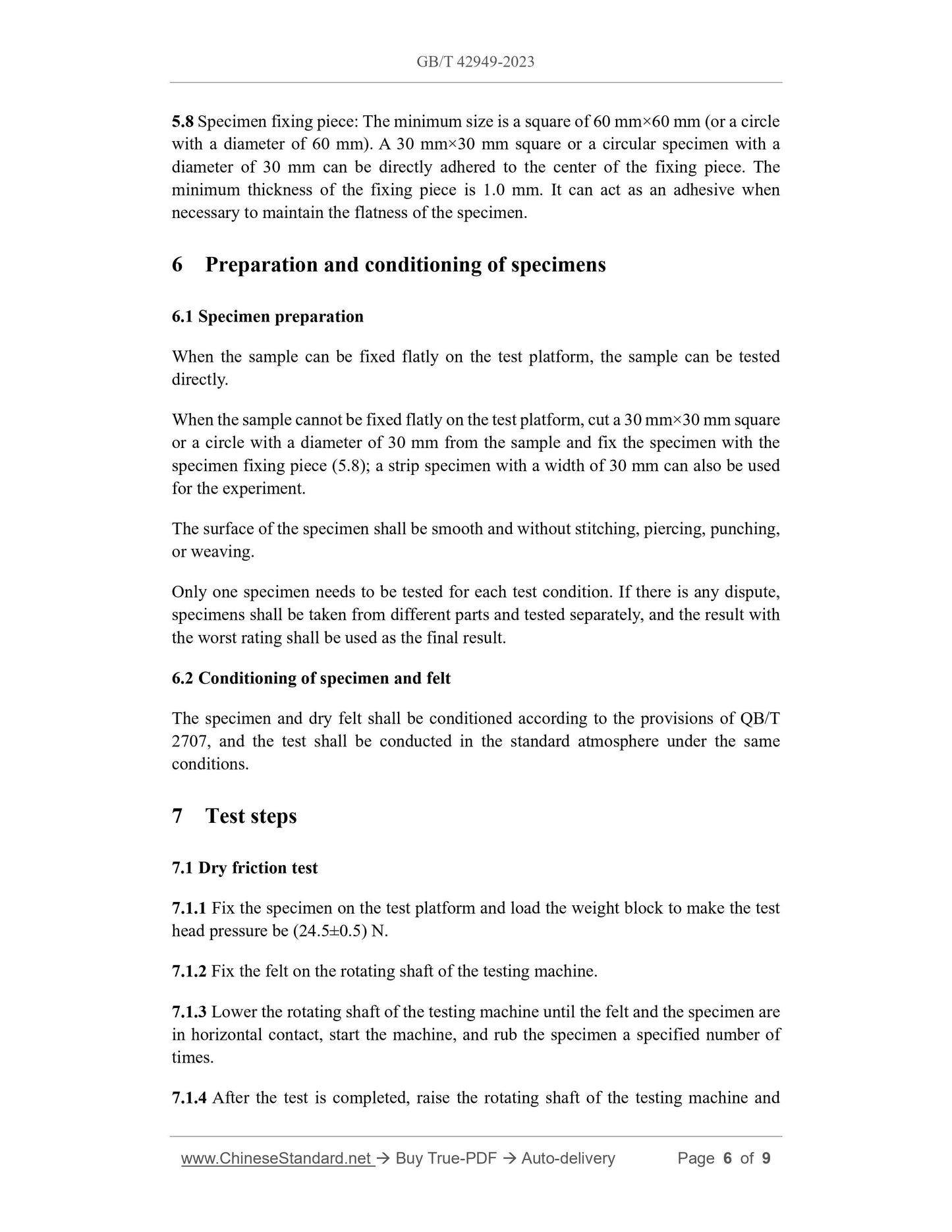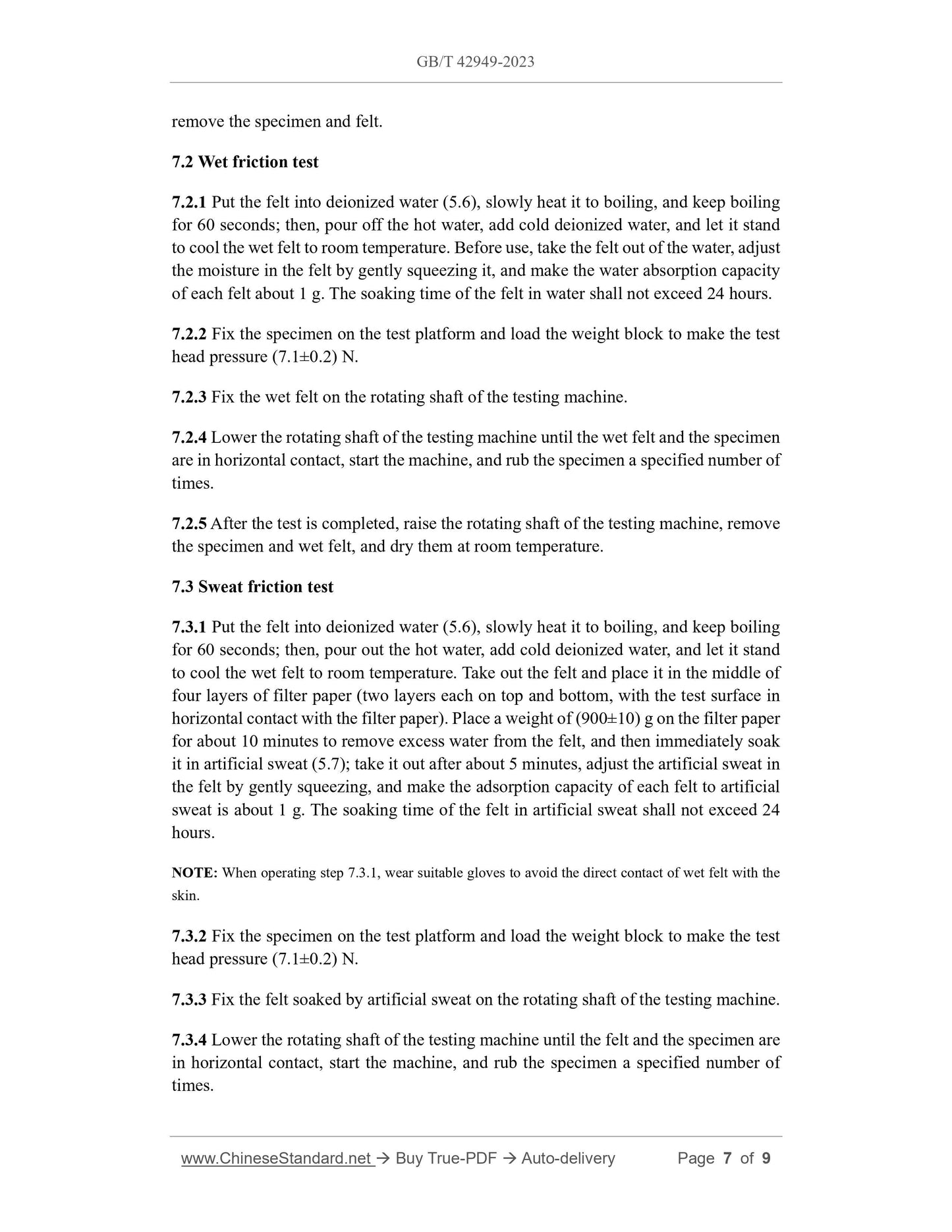1
/
of
5
PayPal, credit cards. Download editable-PDF and invoice in 1 second!
GB/T 42949-2023 English PDF (GB/T42949-2023)
GB/T 42949-2023 English PDF (GB/T42949-2023)
Regular price
$120.00 USD
Regular price
Sale price
$120.00 USD
Unit price
/
per
Shipping calculated at checkout.
Couldn't load pickup availability
Delivery: 3 seconds. Download true-PDF + Invoice.
Get QUOTATION in 1-minute: Click GB/T 42949-2023
Historical versions: GB/T 42949-2023
Preview True-PDF (Reload/Scroll if blank)
GB/T 42949-2023: Leather - Tests for colour fastness - Colour fastness to rotational rubbing
GB/T 42949-2023
GB
NATIONAL STANDARD OF THE
PEOPLE'S REPUBLIC OF CHINA
ICS 59.140.30
CCS Y 46
Leather - Tests for colour fastness - Colour fastness to
rotational rubbing
ISSUED ON: AUGUST 6, 2023
IMPLEMENTED ON: MARCH 1, 2024
Issued by: State Administration for Market Regulation;
Standardization Administration of PRC.
Table of Contents
Foreword ... 3
1 Scope ... 4
2 Normative references ... 4
3 Terms and definitions ... 4
4 Principles ... 4
5 Apparatus and materials ... 5
6 Preparation and conditioning of specimens ... 6
7 Test steps ... 6
8 Result evaluation ... 8
9 Assessment error ... 8
10 Test report ... 8
Leather - Tests for colour fastness - Colour fastness to
rotational rubbing
1 Scope
This document describes a test method for the colour fastness to rotational rubbing of
leather.
This document is applicable to the determination of colour fastness to rotational rubbing
of various types of leather and leather products.
2 Normative references
The following documents contain the provisions which, through normative reference in
this document, constitute the essential provisions of this document. For the dated
referenced documents, only the versions with the indicated dates are applicable to this
document; for the undated referenced documents, only the latest versions (including all
the amendments) are applicable to this document.
GB/T 250 Textiles - Tests for colour fastness - Grey scale for assessing change in
colour
GB/T 251 Textiles - Tests for colour fastness - Grey scale for assessing staining
GB/T 6151 Textiles - Tests for colour fastness - General principles of testing
GB/T 6682 Water for analytical laboratory use - Specification and test methods
GB/T 42165 Leather - Tests for colour fastness - Colour fastness to perspiration
QB/T 2707 Leather - Physical and mechanical tests - Sample preparation and
conditioning
3 Terms and definitions
There are no terms or definitions that need to be defined in this document.
4 Principles
Under the specified pressure, a felt is used to rotate and rub on the surface of the leather
specimen for the specified number of times, and then a grey scale is used to assess the
5.8 Specimen fixing piece: The minimum size is a square of 60 mm×60 mm (or a circle
with a diameter of 60 mm). A 30 mm×30 mm square or a circular specimen with a
diameter of 30 mm can be directly adhered to the center of the fixing piece. The
minimum thickness of the fixing piece is 1.0 mm. It can act as an adhesive when
necessary to maintain the flatness of the specimen.
6 Preparation and conditioning of specimens
6.1 Specimen preparation
When the sample can be fixed flatly on the test platform, the sample can be tested
directly.
When the sample cannot be fixed flatly on the test platform, cut a 30 mm×30 mm square
or a circle with a diameter of 30 mm from the sample and fix the specimen with the
specimen fixing piece (5.8); a strip specimen with a width of 30 mm can also be used
for the experiment.
The surface of the specimen shall be smooth and without stitching, piercing, punching,
or weaving.
Only one specimen needs to be tested for each test condition. If there is any dispute,
specimens shall be taken from different parts and tested separately, and the result with
the worst rating shall be used as the final result.
6.2 Conditioning of specimen and felt
The specimen and dry felt shall be conditioned according to the provisions of QB/T
2707, and the test shall be conducted in the standard atmosphere under the same
conditions.
7 Test steps
7.1 Dry friction test
7.1.1 Fix the specimen on the test platform and load the weight block to make the test
head pressure be (24.5±0.5) N.
7.1.2 Fix the felt on the rotating shaft of the testing machine.
7.1.3 Lower the rotating shaft of the testing machine until the felt and the specimen are
in horizontal contact, start the machine, and rub the specimen a specified number of
times.
7.1.4 After the test is completed, raise the rotating shaft of the testing machine and
remove the specimen and felt.
7.2 Wet friction test
7.2.1 Put the felt into deionized water (5.6), slowly heat it to boiling, and keep boiling
for 60 seconds; then, pour off the hot water, add cold deionized water, and let it stand
to cool the wet felt to room temperature. Before use, take the felt out of the water, adjust
the moisture in the felt by gently squeezing it, and make the water absorption capacity
of each felt about 1 g. The soaking time of the felt in water shall not exceed 24 hours.
7.2.2 Fix the specimen on the test platform and load the weight block to make the test
head pressure (7.1±0.2) N.
7.2.3 Fix the wet felt on the rotating shaft of the testing machine.
7.2.4 Lower the rotating shaft of the testing machine until the wet felt and the specimen
are in horizontal contact, start the machine, and rub the specimen a specified number of
times.
7.2.5 After the test is completed, raise the rotating shaft of the testing machine, remove
the specimen and wet felt, and dry them at room temperature.
7.3 Sweat friction test
7.3.1 Put the felt into deionized water (5.6), slowly heat it to boiling, and keep boiling
for 60 seconds; then, pour out the hot water, add cold deionized water, and let it stand
to cool the wet felt to room temperature. Take out the felt and place it in the middle of
four layers of filter paper (two layers each on top and bottom, with the test surface in
horizontal contact with the filter paper). Place a weight of (900±10) g on the filter paper
for about 10 minutes to remove excess water from the felt, and then immediately soak
it in artificial sweat (5.7); take it out after about 5 minutes, adjust the artificial sweat in
the felt by gently squeezing, and make the adsorption capacity of each felt to artificial
sweat is about 1 g. The soaking time of the felt in artificial sweat shall not exceed 24
hours.
NOTE: When operating step 7.3.1, wear suitable gloves to avoid the direct contact of wet felt with the
skin.
7.3.2 Fix the specimen on the test platform and load the weight block to make the test
head pressure (7.1±0.2) N.
7.3.3 Fix the felt soaked by artificial sweat on the rotating shaft of the testing machine.
7.3.4 Lower the rotating shaft of the testing machine until the felt and the specimen are
in horizontal contact, start the machine, and rub the specimen a specified number of
times.
Get QUOTATION in 1-minute: Click GB/T 42949-2023
Historical versions: GB/T 42949-2023
Preview True-PDF (Reload/Scroll if blank)
GB/T 42949-2023: Leather - Tests for colour fastness - Colour fastness to rotational rubbing
GB/T 42949-2023
GB
NATIONAL STANDARD OF THE
PEOPLE'S REPUBLIC OF CHINA
ICS 59.140.30
CCS Y 46
Leather - Tests for colour fastness - Colour fastness to
rotational rubbing
ISSUED ON: AUGUST 6, 2023
IMPLEMENTED ON: MARCH 1, 2024
Issued by: State Administration for Market Regulation;
Standardization Administration of PRC.
Table of Contents
Foreword ... 3
1 Scope ... 4
2 Normative references ... 4
3 Terms and definitions ... 4
4 Principles ... 4
5 Apparatus and materials ... 5
6 Preparation and conditioning of specimens ... 6
7 Test steps ... 6
8 Result evaluation ... 8
9 Assessment error ... 8
10 Test report ... 8
Leather - Tests for colour fastness - Colour fastness to
rotational rubbing
1 Scope
This document describes a test method for the colour fastness to rotational rubbing of
leather.
This document is applicable to the determination of colour fastness to rotational rubbing
of various types of leather and leather products.
2 Normative references
The following documents contain the provisions which, through normative reference in
this document, constitute the essential provisions of this document. For the dated
referenced documents, only the versions with the indicated dates are applicable to this
document; for the undated referenced documents, only the latest versions (including all
the amendments) are applicable to this document.
GB/T 250 Textiles - Tests for colour fastness - Grey scale for assessing change in
colour
GB/T 251 Textiles - Tests for colour fastness - Grey scale for assessing staining
GB/T 6151 Textiles - Tests for colour fastness - General principles of testing
GB/T 6682 Water for analytical laboratory use - Specification and test methods
GB/T 42165 Leather - Tests for colour fastness - Colour fastness to perspiration
QB/T 2707 Leather - Physical and mechanical tests - Sample preparation and
conditioning
3 Terms and definitions
There are no terms or definitions that need to be defined in this document.
4 Principles
Under the specified pressure, a felt is used to rotate and rub on the surface of the leather
specimen for the specified number of times, and then a grey scale is used to assess the
5.8 Specimen fixing piece: The minimum size is a square of 60 mm×60 mm (or a circle
with a diameter of 60 mm). A 30 mm×30 mm square or a circular specimen with a
diameter of 30 mm can be directly adhered to the center of the fixing piece. The
minimum thickness of the fixing piece is 1.0 mm. It can act as an adhesive when
necessary to maintain the flatness of the specimen.
6 Preparation and conditioning of specimens
6.1 Specimen preparation
When the sample can be fixed flatly on the test platform, the sample can be tested
directly.
When the sample cannot be fixed flatly on the test platform, cut a 30 mm×30 mm square
or a circle with a diameter of 30 mm from the sample and fix the specimen with the
specimen fixing piece (5.8); a strip specimen with a width of 30 mm can also be used
for the experiment.
The surface of the specimen shall be smooth and without stitching, piercing, punching,
or weaving.
Only one specimen needs to be tested for each test condition. If there is any dispute,
specimens shall be taken from different parts and tested separately, and the result with
the worst rating shall be used as the final result.
6.2 Conditioning of specimen and felt
The specimen and dry felt shall be conditioned according to the provisions of QB/T
2707, and the test shall be conducted in the standard atmosphere under the same
conditions.
7 Test steps
7.1 Dry friction test
7.1.1 Fix the specimen on the test platform and load the weight block to make the test
head pressure be (24.5±0.5) N.
7.1.2 Fix the felt on the rotating shaft of the testing machine.
7.1.3 Lower the rotating shaft of the testing machine until the felt and the specimen are
in horizontal contact, start the machine, and rub the specimen a specified number of
times.
7.1.4 After the test is completed, raise the rotating shaft of the testing machine and
remove the specimen and felt.
7.2 Wet friction test
7.2.1 Put the felt into deionized water (5.6), slowly heat it to boiling, and keep boiling
for 60 seconds; then, pour off the hot water, add cold deionized water, and let it stand
to cool the wet felt to room temperature. Before use, take the felt out of the water, adjust
the moisture in the felt by gently squeezing it, and make the water absorption capacity
of each felt about 1 g. The soaking time of the felt in water shall not exceed 24 hours.
7.2.2 Fix the specimen on the test platform and load the weight block to make the test
head pressure (7.1±0.2) N.
7.2.3 Fix the wet felt on the rotating shaft of the testing machine.
7.2.4 Lower the rotating shaft of the testing machine until the wet felt and the specimen
are in horizontal contact, start the machine, and rub the specimen a specified number of
times.
7.2.5 After the test is completed, raise the rotating shaft of the testing machine, remove
the specimen and wet felt, and dry them at room temperature.
7.3 Sweat friction test
7.3.1 Put the felt into deionized water (5.6), slowly heat it to boiling, and keep boiling
for 60 seconds; then, pour out the hot water, add cold deionized water, and let it stand
to cool the wet felt to room temperature. Take out the felt and place it in the middle of
four layers of filter paper (two layers each on top and bottom, with the test surface in
horizontal contact with the filter paper). Place a weight of (900±10) g on the filter paper
for about 10 minutes to remove excess water from the felt, and then immediately soak
it in artificial sweat (5.7); take it out after about 5 minutes, adjust the artificial sweat in
the felt by gently squeezing, and make the adsorption capacity of each felt to artificial
sweat is about 1 g. The soaking time of the felt in artificial sweat shall not exceed 24
hours.
NOTE: When operating step 7.3.1, wear suitable gloves to avoid the direct contact of wet felt with the
skin.
7.3.2 Fix the specimen on the test platform and load the weight block to make the test
head pressure (7.1±0.2) N.
7.3.3 Fix the felt soaked by artificial sweat on the rotating shaft of the testing machine.
7.3.4 Lower the rotating shaft of the testing machine until the felt and the specimen are
in horizontal contact, start the machine, and rub the specimen a specified number of
times.
Share
